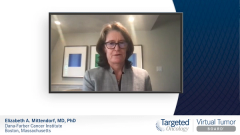
Case 1: 53-Year-Old Woman With TNBC
Elizabeth Mittendorf, MD, PhD, reviews the case of a 53-year-old woman with PD-L1+ TNBC breast cancer and the panel discusses relevant clinical trial data.
Episodes in this series

Elizabeth A. Mittendorf, MD, PhD: Welcome, everybody. I’m pleased to be moderating this session for Targeted Oncology, and I’m joined by 2 good friends and colleagues, Dr David Hicks, a renowned breast pathologist, and Dr Ruta Rao, who is a breast medical oncologist. We have a couple of interesting cases to present this evening that highlight the important advances recently made in breast cancer. Why don’t we go ahead and jump right in with the first case? Our first patient is a postmenopausal woman, 53 years old, who about 2 and a half years ago was diagnosed with triple-negative breast cancer. She had a self-palpated mass in her left breast. She’s very active and has 2 teenage kids. At the time of that initial diagnosis, she had what was thought to be about a 2.8-cm tumor with axillary lymph node involvement. Ruta, as is probably in your practice as well, we initiated preoperative systemic therapy for a biopsy diagnosis of an invasive ductal carcinoma, grade 3, ER, PR, and HER2-negative. In our practice, we do FNA [fine needle aspiration] of those lymph nodes, and that did confirm that diagnosis, clinically node-positive. She had genetic testing. She was not a BRCA1/2 mutation carrier. She went on to get her preoperative systemic therapy, and then I took her to the operating room for a mastectomy with axillary lymph node dissection.
On final pathology, she still had a ypT2N1 tumor. The tumor was about 2.3 cm, and there were 2 out of 20 positive nodes. In our practice, with that residual disease, she would get capecitabine, which she did, and then did well until about 18 months after her surgical procedure, at which time she came to our medical oncologists with worsening cough and abdominal pain. At that time routine imaging showed 3 lesions in her left lung, all which were less than 2 cm, and several liver lesions. We performed a biopsy, which confirmed metastatic triple-negative breast cancer, and then we assessed for PD-L1 status using the Ventana SP142 assay. It was positive for PD-L1. Do you typically rebiopsy these patients in this setting?
Ruta Rao, MD: In our practice, we typically do rebiopsy these patients, especially if there’s something that’s amenable to biopsy. If her lung lesions or liver lesions are something that are easy for the interventional radiologist to biopsy, then we would ask for it. We would do this first to confirm it’s a diagnosis of breast cancer that’s metastatic to those sites. Then we do it to repeat the receptors status, and oftentimes more and more now, to do additional testing, including PD-L1 and sometimes next-generation sequencing.
Elizabeth A. Mittendorf, MD, PhD: With respect to PD-L1, what would be your thoughts with this patient, PD-L1 positive, given the fact that she’s about 18 months out from her initial treatment? What are you thinking about an appropriate regimen for this metastatic diagnosis?
Ruta Rao, MD: Now we’re talking about her receiving first-line metastatic chemotherapy. I think we have good data, in this setting in the first line, for her to receive immunotherapy along with her chemotherapy. Knowing that her PD-L1 status is positive, it tells us she is more likely to respond to the immunotherapy, chemotherapy combination than if she were negative.
Elizabeth A. Mittendorf, MD, PhD: David, I think I mentioned that we had sent the biopsy tissue for the Ventana SP142 assay, which I always think as kind of partnering with atezolizumab. As the pathologist, which tissue do you want to be assessing for PD-L1, the metastatic or the primary tumor? What are you doing at your institution with respect to which antibody you’re using to look for PD-L1 expression?
David G. Hicks, MD: Sure. I think the natural tendency would be to ask for PD-L1 on the biopsy of the metastatic disease, but we know from the IMpassion130 study that some sites of metastatic disease will have lower levels of PD-L1 expression. We certainly could test the liver or the lung metastasis, but if that was negative, I don’t think we’ve totally excluded PD-L1. At that point, I would want to track down the primary and repeat the tests on the primary. When atezolizumab was approved, we brought in SP142 and went through a validation process. Now, with the approval of pembrolizumab, we have more recently approved a second PD-L1 antibody, 22C3, and it leads to all kinds of confusion. You can no longer order PD-L1 testing on breast tissue; you have to tell the laboratory which one you want. We’ve had some requests from medical oncologists to do PD-L1 testing on their patients with triple-negative disease, and you call them up and you say, “Which antibody or drug were you considering?” They’re a little surprised, and so then we go through the options. Most of the time they want both of them. So, more and more, we’ve been doing both SP142 and 22C3.
Elizabeth A. Mittendorf, MD, PhD: I have one comment on something you pointed out with your initial response. We know from the IMpassion130 trial that about 41% of patients were PD-L1 positive, but that trial did not require that it was the metastatic site that be tested and a fair percentage had it in the archive site. At least in our experience, with the initial use of atezolizumab and nab-paclitaxel for these patients with metastatic triple-negative breast cancer, we, as you suggested, start by testing that metastatic site, and our rate of positivity is much lower. It’s about 24% or so. Ruta, what are you guys seeing in Chicago with respect to PD-L1 status and testing?
Ruta Rao, MD: We haven’t done it on the primary site and the metastatic site of the same patient typically. We do what David said, if we can’t get it on the metastatic site or if it’s negative on there, then we go back and test the primary. But I agree with you, from what I’ve seen, it does seem to be at a lower positivity rate in the metastatic sites.
Transcript edited for clarity.














































